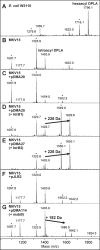Characterization of htrB and msbB mutants of the light organ symbiont Vibrio fischeri
- PMID: 18065606
- PMCID: PMC2227739
- DOI: 10.1128/AEM.02138-07
Characterization of htrB and msbB mutants of the light organ symbiont Vibrio fischeri
Abstract
Bacterial lipid A is an important mediator of bacterium-host interactions, and secondary acylations added by HtrB and MsbB can be critical for colonization and virulence in pathogenic infections. In contrast, Vibrio fischeri lipid A stimulates normal developmental processes in this bacterium's mutualistic host, Euprymna scolopes, although the importance of lipid A structure in this symbiosis is unknown. To further examine V. fischeri lipid A and its symbiotic function, we identified two paralogs of htrB (designated htrB1 and htrB2) and an msbB gene in V. fischeri ES114 and demonstrated that these genes encode lipid A secondary acyltransferases. htrB2 and msbB are found on the Vibrio "housekeeping" chromosome 1 and are conserved in other Vibrio species. Mutations in htrB2 and msbB did not impair symbiotic colonization but resulted in phenotypic alterations in culture, including reduced motility and increased luminescence. These mutations also affected sensitivity to sodium dodecyl sulfate, kanamycin, and polymyxin, consistent with changes in membrane permeability. Conversely, htrB1 is located on the smaller, more variable vibrio chromosome 2, and an htrB1 mutant was wild-type-like in culture but appeared attenuated in initiating the symbiosis and was outcompeted 2.7-fold during colonization when mixed with the parent. These data suggest that htrB2 and msbB play conserved general roles in vibrio biology, whereas htrB1 plays a more symbiosis-specific role in V. fischeri.
Figures







References
-
- Boettcher, K. J., E. G. Ruby, and M. J. McFall-Ngai. 1996. Bioluminescence in the symbiotic squid Euprymna scolopes is controlled by daily biological rhythm. J. Comp. Physiol. A 179:65-73.
-
- Boylan, M., C. Miyamoto, L. Wall, A. Grahm, and E. Meighen. 1989. Lux C, D, and E genes of the Vibrio fischeri luminescence operon code for the reductase, transferase, and synthetase enzymes involved in aldehyde biosyntheses. Photochem. Photobiol. 49:681-688. - PubMed
-
- Caroff, M., L. Aussel, H. Zarrouk, A. Martin, J. C. Richards, H. Therisod, M. B. Perry, and D. Karibian. 2001. Structural variability and originality of the Bordetella endotoxins. J. Endotoxin Res. 7:63-68. - PubMed
Publication types
MeSH terms
Substances
Grants and funding
LinkOut - more resources
Full Text Sources
Molecular Biology Databases

